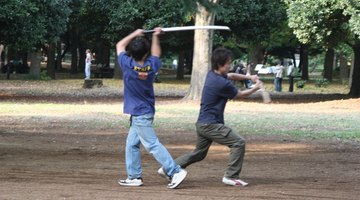How to Make a Wooden Samurai Sword
The Samurai sword is one of the time honored traditions of Japan and as such, it has withstood the test of time since the early 1400s. Slightly curved, a real Samurai sword has one edge and the blade measures about 29 inches in length.

Things You Will Need
- Hickory wood (one board, 1.5” thick x 2.5” wide x 45” long)
- Measuring tape
- Band saw
- Pencil
- Belt sander
- Tung oil
Training to use the weapon is dangerous and to this end, teachers early on required their students to obtain a practice sword made from wood. Traditionally referred to as a bokken, this practice sword could be crudely made or, depending on the skill of the craftsman and the tools available, exceedingly exquisite. Follow these steps and you will learn how to make a wooden Samurai sword and have a great practice sword that will actually withstand quite a bit of play.
-
Visit the local lumber yard and find a straight hickory wood board. There should be no knots or gashes, and when you lean hard on the board, it should not be cracking noticeably. This tips you off to the actual density of the board; the more density, the more durability you will enjoy.
-
Measure the length of the board and mark off 40 inches. Next, measure the width and mark off two inches.
-
Saw the hickory board to these dimensions.
-
Pencil in the curvature of the samurai sword by first measuring 10” on one side for the handle and have this area touch the edge of the board closest to you. Next, factor in the tip of the sword which will touch the furthest edge closest to you; the curvature will touch the opposite side of the board in the middle of the remaining 30 inches and then once again taper off. Keep the width of the blade at 1-1/2 inches.
-
Saw the desired shape. Work slowly to ensure that you get the curvature correct and do not have to go over it twice or follow up by hand. Stop here and get a feel for how the sword lays in your hand; if it feels weighted and allows for comfortably maneuvering, you are done cutting. Conversely, if it feels off and not at all comfortable you might want to go ahead and play around with the curvature just a bit more.
-
Sand the wooden Samurai sword to round the blade and also create a handle that has a slightly oval shape. You should still have the measurements on the wood to know where the 10” of the blade are measured. Take your time with this and work slowly until you get the hang of working with a sander. If you take off too much too quickly you may end up with weak spots in the wood. Pay special attention to the tip of your bokken and round it off. Since it is only a practice sword, you do not need the pointed edge on it.
-
Wipe off any sawdust and apply Tung oil.
Warning
Do not apply paint, varnish or anything other than Tung oil. Failure to heed this advice will lead to a practice sword that may either fly out of your hands when it becomes sweaty or give you very bad blisters because the moist surface will chafe against your hands. Do not use this bokken in hard combat practice but only in general or simulated combat practice. Although it might withstand a bout or two, you may find yourself back in your garage working on a replacement wooden Samurai sword if you take too many hits.
Resources
Writer Bio
Based in the Los Angeles area, Sylvia Cochran is a seasoned freelance writer focusing on home and garden, travel and parenting articles. Her work has appeared in "Families Online Magazine" and assorted print and Internet publications.
Photo Credits
- Morguefile.com/Daniel T. Yara
- Morguefile.com/Daniel T. Yara
More Articles



